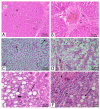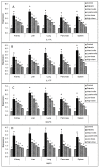Lactiplantibacillus plantarum and Saussurea costus as Therapeutic Agents against a Diabetic Rat Model-Approaches to Investigate Pharmacophore Modeling of Human IkB Kinase and Molecular Interaction with Dehydrocostus Lactone of Saussurea costus
- PMID: 37367922
- PMCID: PMC10302201
- DOI: 10.3390/metabo13060764
Lactiplantibacillus plantarum and Saussurea costus as Therapeutic Agents against a Diabetic Rat Model-Approaches to Investigate Pharmacophore Modeling of Human IkB Kinase and Molecular Interaction with Dehydrocostus Lactone of Saussurea costus
Abstract
Lactic acid bacteria is well-known as a vital strategy to alleviate or prevent diabetes. Similarly, the plant Saussurea costus (Falc) Lipsch is a preventive power against diabetes. Here, we aimed to determine whether lactic acid bacteria or Saussurea costus is more effective in treating a diabetic rat model in a comparative study manner. An in vivo experiment was conducted to test the therapeutic activity of Lactiplantibacillus plantarum (MW719476.1) and S. costus plants against an alloxan-induced diabetic rat model. Molecular, biochemical, and histological analyses were investigated to evaluate the therapeutic characteristics of different treatments. The high dose of S. costus revealed the best downregulated expression for the IKBKB, IKBKG, NfkB1, IL-17A, IL-6, IL-17F, IL-1β, TNF-α, TRAF6, and MAPK genes compared to Lactiplantibacillus plantarum and the control groups. The downregulation of IKBKB by S. costus could be attributed to dehydrocostus lactone as an active compound with proposed antidiabetic activity. So, we performed another pharmacophore modeling analysis to test the possible interaction between human IkB kinase beta protein and dehydrocostus lactone as an antidiabetic drug. Molecular docking and MD simulation data confirmed the interaction between human IkB kinase beta protein and dehydrocostus lactone as a possible drug. The target genes are important in regulating type 2 diabetes mellitus signaling, lipid and atherosclerosis signaling, NF-κB signaling, and IL-17 signaling pathways. In conclusion, the S. costus plant could be a promising source of novel therapeutic agents for treating diabetes and its complications. Dehydrocostus lactone caused the ameliorative effect of S. costus by its interaction with human IkB kinase beta protein. Further, future studies could be conducted to find the clinical efficacy of dehydrocostus lactone.
Keywords: 16S rRNA gene; Lactiplantibacillus plantarum; Saussurea costus; biochemical; diabetes mellitus; docking; histological analysis; pharmacophore modeling.
Conflict of interest statement
The authors declare no conflict of interest.
Figures















Similar articles
-
Modulation of mammary tumour progression using murine model by ethanol root extract of Saussurea costus (falc.) lipsch.J Ethnopharmacol. 2024 Jan 30;319(Pt 3):117302. doi: 10.1016/j.jep.2023.117302. Epub 2023 Oct 18. J Ethnopharmacol. 2024. PMID: 37858751
-
Aucklandia costus (Syn. Saussurea costus): Ethnopharmacology of an endangered medicinal plant of the himalayan region.J Ethnopharmacol. 2020 Dec 5;263:113199. doi: 10.1016/j.jep.2020.113199. Epub 2020 Jul 27. J Ethnopharmacol. 2020. PMID: 32730877 Review.
-
Antioxidant and Anti-Urolithiatic Activity of Aqueous and Ethanolic Extracts from Saussurea costus (Falc) Lispich Using Scanning Electron Microscopy.Life (Basel). 2022 Jul 11;12(7):1026. doi: 10.3390/life12071026. Life (Basel). 2022. PMID: 35888114 Free PMC article.
-
HPLC-PDA Method for Quantification of Bioactive Compounds in Crude Extract and Fractions of Aucklandia costus Falc. and Cytotoxicity Studies against Cancer Cells.Molecules. 2023 Jun 16;28(12):4815. doi: 10.3390/molecules28124815. Molecules. 2023. PMID: 37375368 Free PMC article.
-
Saussurea costus: botanical, chemical and pharmacological review of an ayurvedic medicinal plant.J Ethnopharmacol. 2007 Apr 4;110(3):379-90. doi: 10.1016/j.jep.2006.12.033. Epub 2007 Jan 20. J Ethnopharmacol. 2007. PMID: 17306480 Review.
Cited by
-
L-shaped relationship between stress hyperglycemia ratio and cardiovascular disease risk in middle-aged and older adults: Insight from the China Health and Retirement Longitudinal Study.PLoS One. 2025 May 20;20(5):e0324978. doi: 10.1371/journal.pone.0324978. eCollection 2025. PLoS One. 2025. PMID: 40392841 Free PMC article.
-
Comparative in silico and in vivo study of the antioxidant activity of lactoferrin, Geobacillus stearothermophilus, and Lactobacillus delbrueckii subsp. lactis against Rotavirus infection in male mice.BMC Microbiol. 2025 Mar 4;25(1):117. doi: 10.1186/s12866-025-03820-z. BMC Microbiol. 2025. PMID: 40038589 Free PMC article.
-
Genetic assessment of litter size, body weight, carcass traits and gene expression profiles in exotic and indigenous rabbit breeds: a study on New Zealand White, Californian, and Gabali rabbits in Egypt.Trop Anim Health Prod. 2024 Aug 22;56(7):244. doi: 10.1007/s11250-024-04082-z. Trop Anim Health Prod. 2024. PMID: 39172291 Free PMC article.
References
-
- Davies M.J., D’Alessio D.A., Fradkin J., Kernan W.N., Mathieu C., Mingrone G., Buse J.B. Management of Hyperglycaemia in Type 2 Diabetes. A Consensus Report by the American Diabetes Association (ADA) and the European Association for the Study of Diabetes (EASD) Diabetologia. 2022;65:1925–1966. doi: 10.1007/s00125-022-05787-2. - DOI - PMC - PubMed
-
- Mammate N., El Oumari F.E., Imtara H., Belchkar S., Lahrichi A., Alqahtani A.S., Houssaini T.S. Antioxidant and Anti-Urolithiatic Activity of Aqueous and Ethanolic Extracts from Saussurea costus (Falc) Lispich Using Scanning Electron Microscopy. Life. 2022;12:1026. doi: 10.3390/life12071026. - DOI - PMC - PubMed
-
- Kumar A., Sharma B. Biomedical implications of plant-based principles as antidepressants: Prospects for novel drug development. Mini Rev. Med. Chem. 2022;22:904–926. - PubMed
LinkOut - more resources
Full Text Sources
Miscellaneous

